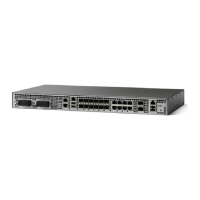BERT
Bit-Error Rate Testing (BERT) is used for analyzing quality and for problem resolution of digital transmission
equipment. BERT tests the quality of an interface by directly comparing a pseudorandom or repetitive test
pattern with an identical locally generated test pattern.
The BERT operation is data-intensive. Regular data cannot flow on the path while the test is in progress. The
path is reported to be in alarm state when BERT is in progress and restored to a normal state after BERT has
been terminated.
The supported BERT patterns are 2^15, 2^20, 2^23, all 0s and all 1s.
BERT is supported in the following two directions:
• Line—Supports BERT in TDM direction.
• System—Supports BERT in PSN direction.
The following table shows the SONET level of BERT patterns supported.
PatternsModes
• 0s—Repeating pattern of zeros.
• 1s—Repeating pattern of ones.
• 2^15-O.151—Pseudo-random O.151 test pattern
that is 32,768 bits in length. Error and Jitter
measurement of 1544, 2048, 6312, 8448, 32064,
44736 kbps.
• 2^20-O.153—Pseudo-random O.153 test pattern
that is 1,048,575 bits in length.
• 2^20-O.151—Pseudo-random QRSS O.151 test
pattern that is 1,048,575 bits in length. Error
and Jitter measurement upto 72 kbps.
• 2^23-O.151—Pseudo-random 0.151 test pattern
that is 8,388,607 bits in length. Error and Jitter
measurement of 34368 kbps and 139264 kbps
SONET Path Level
1-Port OC-192 or 8-Port Low Rate CEM Interface Module Configuration Guide, Cisco IOS XE Everest 16.7.x (Cisco
ASR 900 Series)
25
Configuring SONET
BERT

